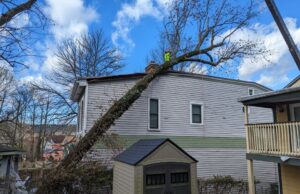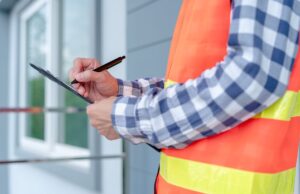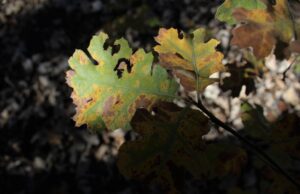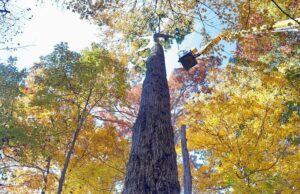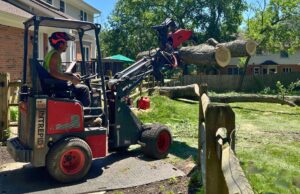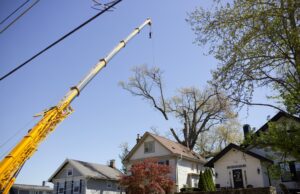Cincinnati homeowners are often confused when it comes to trees growing near power lines. Is it dangerous? Do they need to be trimmed? If so, who is responsible for keeping trees away from powerlines?
Managing trees near powerlines is all about keeping your home and family safe, while also ensuring power lines aren’t damaged, as that can cause a power outage, not just for you, but for dozens or even hundreds of neighbors.
This guide will help answer all those burning questions about tree removal near power lines in Cincinnati. It covers everything from determining when tree trimming or removal is needed to who is responsible, and much more, eliminating headaches and saving you time.
Continue reading to equip yourself with the knowledge you need for a greener, safer Cincinnati yard.
Key Takeaways
- Homeowners in Cincinnati must proactively manage trees near power lines to mitigate safety hazards, including the risk of electrocution and power outages.
- Utility companies like Duke Energy conduct regular maintenance on high-voltage lines but may not always address trees near service lines, making it crucial for homeowners to understand their responsibilities.
- Hiring professional tree services, such as Lefke Tree Experts, offers a safer and more aesthetically pleasing alternative to utility trimming, ensuring trees are managed without compromising property appearance.
- Selecting the right tree species for planting near power lines—such as Flowering Dogwood or Eastern Redbud—can minimize future risks and maintenance, adhering to Cincinnati’s climate and soil types.
- Strategic landscaping and consulting with professionals can enhance yard safety and beauty, keeping trees away from power lines and ensuring compliance with local regulations.
What are the risks from trees growing too close to power lines?
Trees that grow too close to power lines are not just a landscaping issue—they pose significant risks and dangers to homeowners, their properties, and the wider community. Understanding these risks is key to appreciating the importance of managing tree growth near power infrastructure.
Safety Hazards
The primary concern is safety. Trees in close contact with power lines can become conductors of electricity, creating a serious risk of electrocution for anyone touching the tree or even getting too close. During wet conditions, this risk increases significantly.
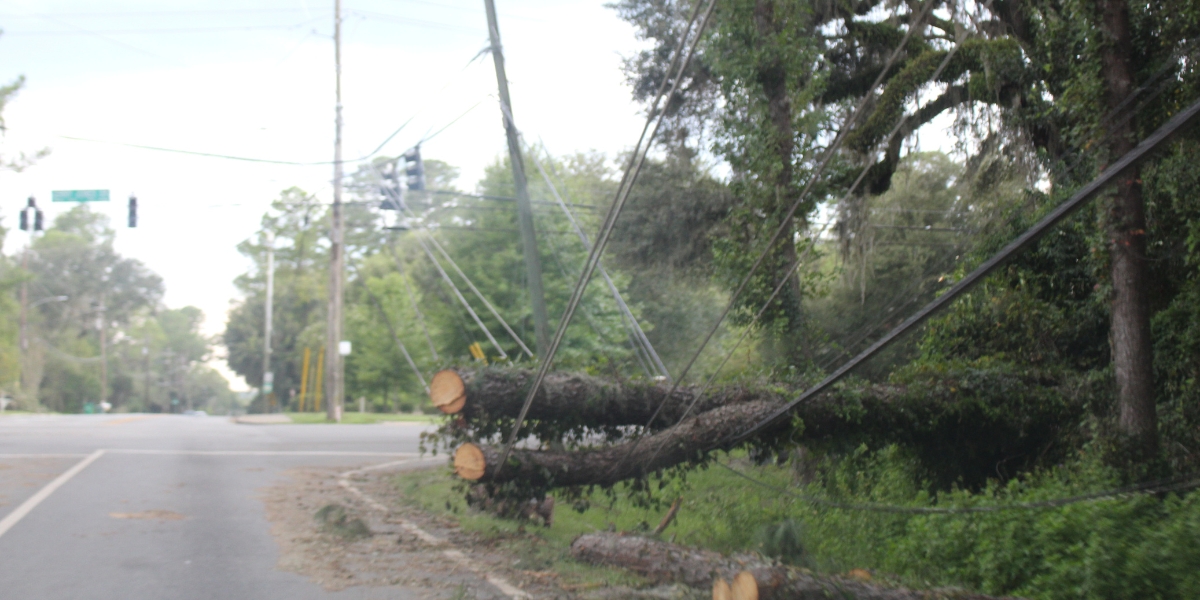
The aftermath of a storm: A vivid reminder of why regular tree trimming is crucial for preventing power outages and ensuring community safety.
Power Outages
Branches that touch or fall onto power lines can disrupt electrical service, leading to outages. Recent storms have led to downed trees taking out power throughout the greater Cincinnati area. Not only is this inconvenient, but it can also result in spoiled food, loss of heating or cooling, and disrupt work-from-home setups and essential medical equipment.
And it’s not just your home at risk. If a tree falls onto a powerline, it can knock out power for your entire street or neighborhood, multiplying the effects of a power outage.
Fire Risks
When trees come into contact with power lines, there’s a potential for sparks that can ignite fires. This is especially concerning in areas prone to dry conditions, but it’s risky anywhere trees and electrical lines intersect.
Property Damage
During storms or high winds, trees or branches that fall onto power lines might also bring down those lines, potentially damaging your property or your neighbors’. Repairing such damage can be costly and time-consuming.
Legal and Financial Responsibilities
As the homeowner, you might be held responsible for any damages resulting from negligence in maintaining trees on your property. This includes damages to power lines and neighboring properties and even fines from local authorities for violating safety regulations.
Increased Maintenance Costs
Utility companies may prune trees to prevent them from growing into power lines, often at your expense. These pruning jobs can be unsightly and may negatively affect the tree’s health and growth pattern.
By staying proactive about managing trees near power lines, you can mitigate these risks, ensuring the safety and reliability of your property’s electricity supply and contributing to the overall well-being of your community..
How do I know if a tree is too close to a power line?
Determining the safe distance between trees and power lines is crucial for Cincinnati homeowners to ensure both the safety of their homes and the reliability of their electricity supply. But how do you know when a tree poses a risk? Here are some guidelines to help you assess the situation:
Consider the Distance
Start with a simple visual check. If branches are within 10 feet of power lines, it’s time to consider action. Any tree within 10 feet of power lines should be professionally trimmed to keep it away from the wires. That should be sufficient to keep it safe unless it’s a very fast-growing tree with a mature size that will put the canopy too close to the power lines. In that case, it’s best to remove it before it gets too large.
Trees growing under power lines should ideally be shorter than 25 feet at full maturity to prevent future issues.
Check Tree Health
Aside from the distance from power lines, look for signs that the tree could be at risk of failure. For example, signs of disease or infestation like discolored leaves, unusual growths, or a sudden loss of foliage indicate that the tree could be weakened, increasing the risk of it falling onto nearby powerlines.
Weather can also be a game-changer. Storms can weaken trees, increasing the potential for falling limbs near powerlines, thus increasing the need for pruning or removal. Inspect your trees carefully after any severe weather events. If you have any concerns about the health or stability of your trees, call a Certified Arborist to inspect it.
Know the Tree’s Mature Height
Are there any smaller trees located underneath a powerline? Whether it was planted by you or by a previous homeowner, it’s important to know how tall that tree will grow so you can anticipate problems before they arise.
Even if a tree is only a few feet tall right now, it can pose a threat in the future if its mature height will come near a powerline. Depending on the tree species, it may be best to remove it now to avoid headaches and expenses later on, as the larger the tree becomes, the more expensive it will be to trim or remove.
Consult Local Guidelines
The City of Cincinnati and local utility companies provide specific guidelines on tree planting and maintenance near power lines. These can offer more precise distances based on the type of power line (e.g., high voltage vs. residential lines).
Get a Professional Consultation
For the best advice, consider hiring a tree service professional like Lefke Tree Experts. We can assess the health of the tree, its growth pattern, and proximity to power lines, providing recommendations based on local regulations and safety standards.
Remember, trees that are too close to power lines not only risk electrical outages but can also become hazardous during storms or high winds, posing a threat to your property and personal safety. If you identify a tree that might be too close to electrical or utility lines, the next step is determining the right course of action, ranging from professional tree trimming to complete removal. Always prioritize safety and consult with professionals or your utility company before making any decisions.
How do I know if my tree should be removed to prevent it from damaging power lines?
Any tree within 10 feet of power lines should be professionally trimmed to keep it away from the wires. That should be sufficient to keep it safe unless it’s a very fast-growing tree with a mature size that will put the canopy too close to the power lines. In that case, it’s best to remove it before it gets too large.
Beyond that, look for signs that the tree could be at risk of failure. For example, signs of disease or infestation like discolored leaves, unusual growths, or a sudden loss of foliage indicate that the tree could be weakened, increasing the risk of it falling onto nearby powerlines.
Weather can also be a game-changer. Storms can weaken trees, increasing the potential for falling limbs near powerlines, thus increasing the need for pruning or removal. Inspect your trees carefully after any severe weather events. If you have any concerns about the health or stability of your trees, call a Certified Arborist to inspect it.
Can I safely remove a small tree near power lines in Cincinnati myself?
While it might be tempting to cut down trees near power lines yourself to save costs or control the outcome, it’s a risky endeavor. Even if the tree is relatively small, working near power lines poses significant safety hazards, including the risk of electrocution. Without the proper training, tools, and safety equipment, you could endanger yourself, your property, and even disrupt power in your neighborhood. Tree service professionals have the expertise to safely navigate these dangers, ensuring the tree removal job is done safely and correctly.
Am I responsible for pruning or removing street trees in front of my house that are growing into electrical lines?
Homeowners are not responsible for this. Cincinnati Parks Urban Forestry maintains the 85,000 public street trees along Cincinnati streets, including inspecting, maintaining, pruning and removing them to remove public tree hazards. You may have recently received an assessment for public tree maintenance in and along the streets and the public right-of-way within the City of Cincinnati’s Urban Forestry Maintenance District.
Cincinnati Parks Urban Forestry provides immediate response to citizen service requests and 24-7 emergency service for downed trees and limbs throughout all Cincinnati neighborhoods.
Is the homeowner responsible for removing a tree near other power lines in Cincinnati?
Not all power lines in and around Cincinnati run along public roads. Many of these overhead lines cross over yards and other areas. The type of line, and its location, determine whose responsibility it is to keep the line clear.
Service lines are those that connect the main powerline to the energy meter on your home. Most of the time, this line hangs over your yard. Homeowners are primarily responsible for keeping these lines free from trees and vegetation.
If you, or a hired professional, plan to work near your service line, you should contact Duke Energy for a complimentary de-energization of the line before starting any tree-related tasks.
Should vegetation significantly interfere with the service line (such as a tree or branch exerting substantial pressure on the line or pole), you can file a tree trimming request, allowing a representative from Duke Energy to assess the situation. However, it is not guaranteed that they will maintain service lines in every situation.
The answer depends largely on the type of power line involved. Duke Energy provides a helpful diagram in their tree trimming guide provided by Duke Energy provides additional information on the types of power lines they are responsible for, and which ones you might be responsible for.
How to Request Tree Trimming from Duke Energy
Are electric lines involved? If there are electric lines involved please call Police Dispatch 513-765-1212 and contact Duke Energy as soon as possible at 1(800)-543-5599.
If you’re concerned about a tree near power lines, Duke Energy encourages customers to contact them using this online Tree Trimming Request form. They can evaluate the situation and determine if the tree falls within their maintenance responsibilities.
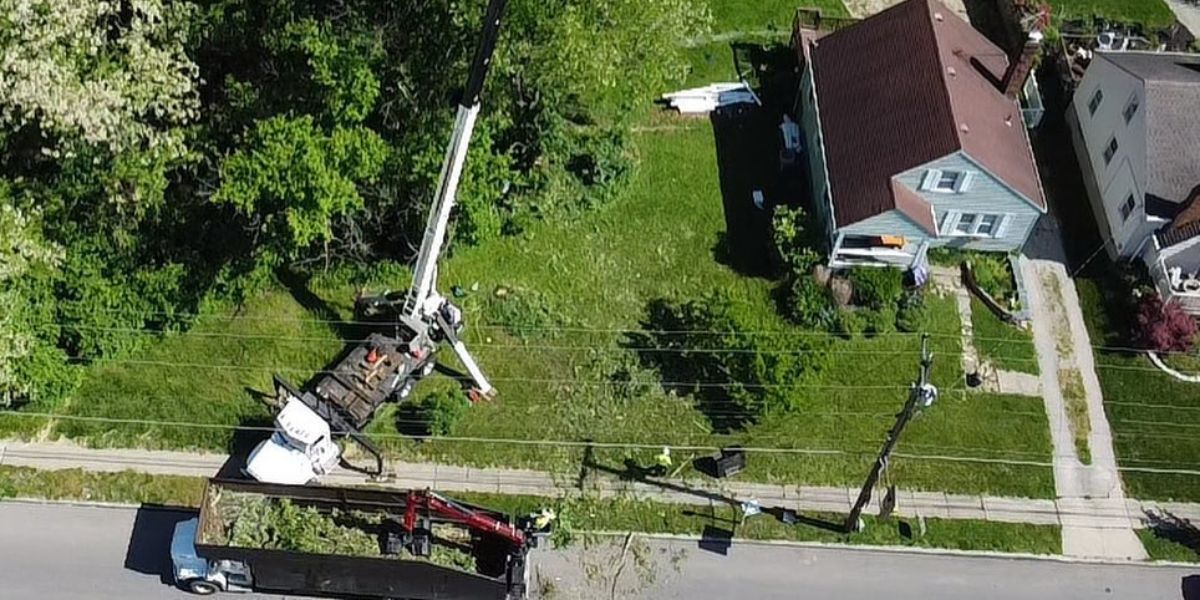
Precision in action: Lefke Tree Experts ensure safe distances between trees and power lines, safeguarding Cincinnati’s homes and electrical infrastructure.
Should I let the utility company trim my trees or is it better to hire a tree service company?
Hiring a tree service professional might be better than leaving it to the utility company when it comes to managing trees near power lines. While utilities are responsible for ensuring safety and preventing outages by clearing trees from power lines, their approach is often more functional than aesthetic. Here’s what you need to know.
- Utilities have the legal right to trim or remove trees threatening the power system’s reliability, thanks to easements in your property deed.
- Ohio electric companies might use their own crews or hire contractors. They follow industry standards to minimize tree harm, but the primary goal is safety, not beauty.
- Utilities trim trees to maintain a safe distance from power lines, which might not always result in the most visually pleasing outcome.
- If utility work leaves your yard looking less than ideal, the cleanup and any corrective landscaping will likely be up to you—and at your expense.
Hiring a professional tree service like Lefke Tree Experts not only reduces the risk of accidents but also ensures your trees receive the best care. These experts know how to prune trees properly, promoting safe growth and preventing diseases.
They’re also familiar with the local regulations regarding tree pruning near powerlines and will ensure your trees are pruned within these guidelines. You’ll also have more control over the process, potentially saving your trees from aggressive utility trimming and keeping your property looking its best.
Are there any regulations in the city of Cincinnati about removing trees close to electrical or utility lines?
There are quite a few legal aspects and regulations tied to tree maintenance, especially when it comes to those close to power lines. The city of Cincinnati has set clear guidelines to ensure the safety and well-being of its residents.
- Tree Clearance from Power Lines: The City of Cincinnati requires that trees be pruned or removed if they come within a certain distance of power lines. This is to prevent accidents, power outages, or fires that could result from contact between trees and power lines.
- Permits for Tree Removal: If a tree is considered a public tree – on the street, in a park, or on other public property – you’ll need a permit from the city’s Urban Forestry Division to prune or remove it.
- Penalties for Non-compliance: Failure to adhere to these regulations can result in hefty fines or legal action from the city.
So, remember, when dealing with trees near power lines, it’s not just about safety, but also about legal responsibilities. Knowing and following the rules will save you from potential headaches down the line.
Do I need a permit in Cincinnati to cut down a tree on my property that’s growing near electrical lines?
If a tree is on your residential property within the city of Cincinnati, you don’t need a permit to remove it.
However, any operation involving a public tree (“street trees” or trees on a public right of way), including removal or pruning, requires a permit regardless of whether the work is done by the homeowner, utility company, or a tree service company. This requirement doesn’t apply in emergency situations or if Cincinnati Parks Urban Forestry deems the tree to be a hazard.
BEFORE YOU START WORK – If you’re planning to remove a tree near the street, be certain that it’s on your property before you start work!
Are tree conflicts with power lines more common during certain times of year?
In Cincinnati, trees grow vigorously during spring and summer, potentially encroaching on power lines. Fall and winter typically see less growth, but heavy snow and ice can weigh branches down, causing them to break or droop onto electrical and utility lines. The bottom line is that trees can grow into or fall onto electrical lines at any time of year.
Does the tree species affect the need for pruning or removal near powerlines?
Different tree species grow at varying rates, with different heights and spread, all of which will affect their ultimate proximity to powerlines. Fast-growing, tall species will need frequent pruning or premature removal to avoid interference with powerlines.
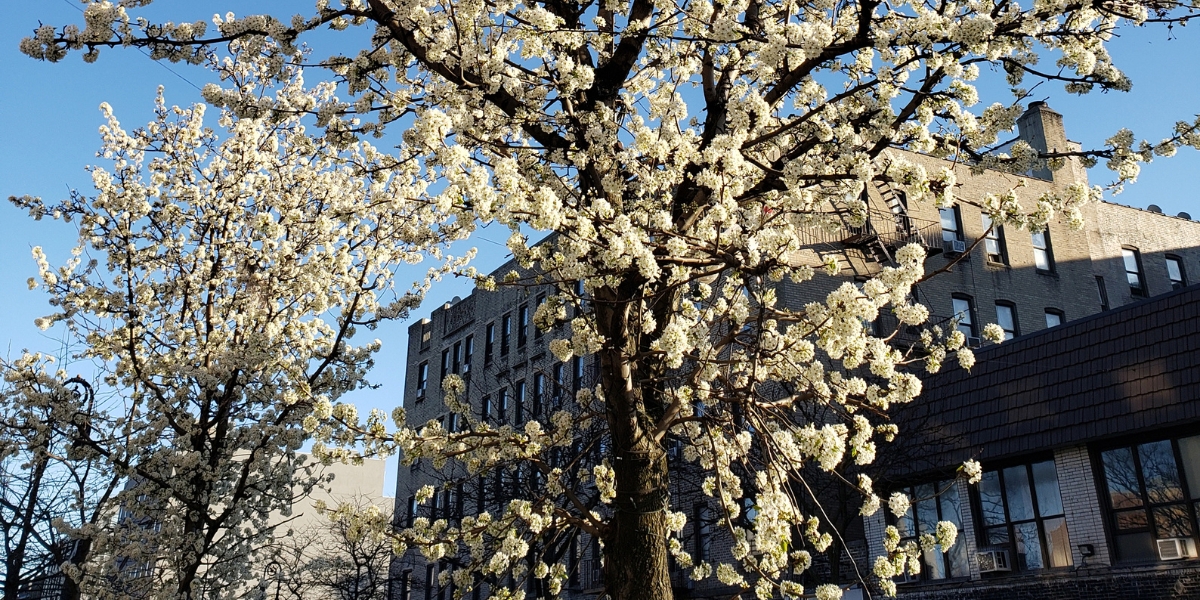
Beauty without compromise: The Flowering Dogwood demonstrates how selecting the right tree species can enhance your yard while keeping safety in mind.
What are the best trees to plant beneath power lines in Ohio?
When selecting trees to plant near power lines, opt for slow-growing or short species to minimize maintenance and safety hazards. For Cincinnati’s climate and soil types, consider these trees.
- Flowering Dogwood – A native species that thrives in Ohio’s climate, offering beautiful spring flowers and manageable growth. They occasionally reach a height of 15 feet and can spread as much as 20 feet wide.
- Eastern Redbud – Another native with stunning spring blooms. This multi-trunked tree can reach 20 feet in both height and width.
- American Hornbeam – This tree is known for its attractive foliage and fruit that resembles hops. When grown in the open, it can reach 30 feet in height and width, though when planted near other species, it often stays smaller.
- Crabapple – Offering beautiful flowers and fruits, crabapple ranges from 8 to 25 feet when mature, depending on the variety. The area underneath powerlines also makes a good location for shrubs and flower beds.
How can I landscape my Cincinnati yard with trees while keeping them away from power lines?
Strategic planning is key to landscaping near power lines. Here are some tips to ensure you won’t need to cut down a tree prematurely to prevent safety issues with electrical wires.
- Research Tree Species: Do your research, whether online, by reading landscaping books, or by speaking to experts at local nurseries in the Cincinnati area to determine the full height and spread of mature trees.
- Consider Both Height and Spread: The eventual height of a tree is an obvious factor. Trees that reach a height over 25 feet high should not be planted underneath or next to power lines. But many homeowners forget about the spread, or how wide a tree’s canopy can spread. Many mature trees can extend 30 feet or more in width.
- Consult Landscape Professionals or Arborists: Engaging a professional who understands which thrive in our local growing environment can provide valuable insights into the right trees for your property and how to plant them safely. Experts can help you navigate local regulations and select species that will thrive in Cincinnati’s climate.
Generally, you should plant small trees, shrubs, or flower beds under and adjacent to power lines, and plant larger trees as far from power lines as possible to allow them to grow to maturity. By choosing the right plants and trees, and carefully planning your landscaping, you can enhance your property’s beauty without compromising safety or running afoul of local guidelines.
Ensuring Safety and Beauty in Your Cincinnati Yard
Navigating the intricacies of planting trees near power lines in Cincinnati requires a careful balance between enhancing your property’s beauty and adhering to safety and local regulations. Choosing the right species, understanding the city’s guidelines, and strategic landscaping are all crucial steps in creating a safe and aesthetically pleasing environment.
However, achieving this balance doesn’t have to be a daunting task. Lefke Tree Experts offers expert guidance and comprehensive tree care solutions tailored to Cincinnati’s unique challenges for homeowners looking to make informed decisions about their trees and landscaping near power lines.
Whether you’re considering planting new trees, need advice on managing existing ones, or require professional trimming or removal services to comply with local regulations, our team is here to help. Call Lefke Tree Experts at 513-325-1783 today to ensure your yard remains a safe, beautiful, and compliant space.
There’s no need to stress about maintaining your trees or endangering yourself by trying to handle the task alone. Let the professionals do what they do best. They’ll provide regular maintenance, ensuring your trees are healthy, beautiful, and safe, particularly those close to powerlines. You can put your trust in their expertise and enjoy the peace of mind that comes with a job well done.

